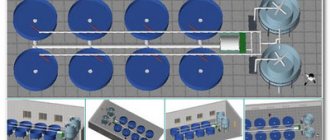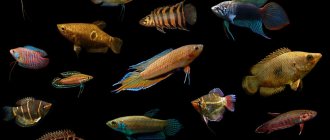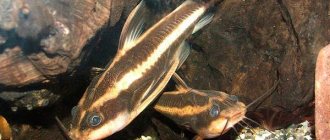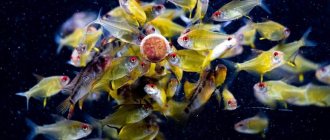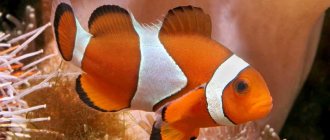In pond warm-water fish farming, the lion's share falls on fish farms engaged in carp breeding. At the same time, in practice it has been established that this type of commercial fish consumes a lot of expensive feed. Far Eastern fish can completely do without special feed. We are talking about herbivorous fish. Herbivorous fish are the most important source of increasing fish production, and the use of polyculture of these fish farming objects makes it possible to utilize a significant part of the primary production.
Regardless of the region of Russia, herbivorous fish provide additional fish production - on average 0.9 t/ha and this is not the limit.
Herbivorous fish are a kind of orderlies, as they consume aquatic vegetation in overgrown ponds and natural reservoirs as food.
A few words about the biological characteristics of herbivorous fish
Spawning requires a strong current. And this is a factor that complicates the reproduction of this fish on the basis of pond fish farms. This obstacle can be overcome by special hatchery workshops, which have all the conditions for obtaining juveniles.
The strategy for obtaining marketable fish in our case involves:
- creating and maintaining optimal conditions for producers who will reach the required sexual maturity within the required time frame,
- pituitary injections,
- obtaining reproductive products, which include milt and caviar,
- mixing eggs and ejaculate followed by incubation of the former,
- rearing of larvae followed by rearing of fingerlings,
- wintering,
- bringing the object of cultivation to sales mass.
Manufacturer maintenance technology
Types of herbivorous fish that are widespread in the Russian Federation:
- Silver carp, including white and motley.
- White amur.
Features of winter fishing on the Volga
Flavoring additives for carp bait
Catching carp using peas
The diet of silver carp includes phytoplankton, and that of bighead carp includes phytoplankton and zooplankton. Grass carp feeds on soft aquatic and terrestrial vegetation.
The first stage in the formation of breeding stock is the importation of mature breeders or older replacement stock. The size of the queen cell is primarily determined by the planned release of larvae.
The ratio of male and female individuals is 3-4 to 5. When breeding herbivorous fish, you cannot do without a reserve fund of producers - usually 50% of the producers. Annual culling is 20% of the total breeding stock.
Criteria taken into account when selecting fish for breeding: weight, fertility and the presence of complete reproductive products (spawn, ejaculate).
Males and females are kept in brood ponds in the summer. For each hectare of reservoir there should be 100 individuals of silver carp, grass carp and half as many bighead carp.
Over the summer, manufacturers increase the weight by at least a kilogram.
Replacement stock is kept in summer-repair reservoirs. Its planting density is determined by natural productivity - a maximum of 0.5 thousand per hectare.
During the summer maintenance of breeders and repair groups, reservoirs are fertilized to improve the food supply. If there is a lack of aquatic vegetation for grass carp, it is fed with terrestrial vegetation. Compound feed should not be given, as he is delayed in growth and puberty.
In the southern regions, for wintering, herbivorous fish are planted in ordinary wintering ponds, in regions with a temperate climate - in cages, the water of which is supplied from thermal power plants and state district power plants. The average planting density in ponds is 15 tons per hectare.
Fish farm: business plan
Fish farming is not a new business idea, but its relevance today is only increasing. The option of maintaining your own pond or pond is a profitable business. But at the initial stage it requires substantial investments and competent organization of the process.
First, you should find a plot of land suitable for installing a pool with cages. A prerequisite for successful fish production is the presence of a special filter and equipment necessary for a particular breed of fish.
Purchasing young animals will also require significant financial costs. Keep in mind that the price of larvae is higher than that of grown individuals. It is also necessary to calculate the natural losses of the fry during the rearing process. On average, this amount is up to 10%. It will be possible to raise a full-fledged adult from a fry only after two to two and a half years.
Any business project begins with drawing up a business plan. An assessment of the fish market makes it possible to conclude that carp is the most popular product on fish counters.
Estimated estimate for organizing a fish farm for growing carp:
- Purchase of fry carp for replanting in cages - about ten thousand rubles;
- The salary of farm employees is thirty thousand rubles;
- A batch of feed for carp larvae and a vitamin mixture – seven to eight thousand rubles;
- Other expenses (payment for water, electricity, gas for heating the pool) - twenty to twenty-five thousand rubles.
In total, the approximate amount you need to have to start a fish farm is about seventy thousand in national currency. Therefore, a fish farm is classified as a business with an investment category of up to one hundred thousand rubles. For the northern regions of Russia, this amount increases significantly and amounts to approximately five hundred thousand.
As for profit, without deducting taxes and fees, it ranges from one hundred thirty to one hundred and fifty rubles. However, you can count on profit no earlier than in two to two and a half years. By this time, the carp fry turns into an adult and its weight is one to two kilograms.
Carp, like no other species, is suitable for organizing a fish farming business. This is due to its unpretentiousness in food and maintenance. And the rapid growth of carp fry will help you quickly recoup costs and generate income. However, you should not neglect the quality of conditions for keeping fish and feed. Consumerism can lead to the development of pathologies in fry and their death, as well as non-compliance of adult carp meat with sanitary standards.
Obtaining fish for reproduction
The degree of sexual maturity of herbivorous fish is determined by the readiness of sexual products (eggs, milt) for fertilization.
At a water temperature of 20 degrees. ponds are drained and breeders are captured. This is followed by culling, sorting by species, sex and degree of readiness for the spawning campaign.
Dividing females and males based on their readiness for spawning:
Females:
Group I. Individuals with obvious readiness to spawn. These can be identified by their full, soft belly. Such females are used first in the current year.
Group II. The readiness for spawning of such females is less pronounced, so they are used secondarily.
III group. These are females without signs of readiness to spawn (usually immature).
Males:
Group I. The mating plumage is pronounced, and the ejaculate is easily released. Such fish are used first.
Group II. There is no breeding plumage, and sperm is released only with significant pressure on the abdomen. Such fish are either not used this year or used when necessary.
In the southern regions, after sorting, the spawners are planted in small (0.05-0.1 ha) pre-spawning ponds, the depth of which is 1.5-2 m. Constant water exchange is organized. The planting density is 1 thousand individuals per hectare. They keep fish in such ponds for about a month.
In colder climates, spawners from overwintering cages are placed in hatchery tanks or trays where they are maintained until spawning temperature.
In herbivorous fish, reproductive products mature at different times. Initially, work is carried out with grass carp and silver carp. Not earlier than a week later - with bighead carp.
The best aquarium fish of the labyrinth family
Cockerels
The cockerel is famous for its fighting spirit. Incredibly beautiful colorful males see each fellow of their subspecies as a potential invader, so they regularly start fights, trying to divide the territory.
Even for an aggressive fish, a natural fight with an opponent is serious stress. Therefore, you should not place two bettas in one joint aquarium for fun.
In addition to the character and external gloss, the “calling card” of this fish remains its extreme unpretentiousness. But in suitable conditions, the cockerel will live longer. For good maintenance, it will require a temperature of 24-27 degrees, the softest possible water and approximately 5 liters of space for each individual. Due to its special internal structure, it needs access to air.
- bright appearance;
- can be kept in any containers;
- behaves calmly in a common tank without competitors from its own species;
- unpretentious;
- practically does not get sick at a suitable water temperature.
- males tend to fight;
- spawns only in a separate reservoir.
Pituitary injections
During the breeding season in pond conditions, herbivorous fish lack the full range of spawning factors; the pituitary gland of fish does not secrete the required amount of gonadotropic hormones. As a result, the final maturation of eggs and their ovulation do not occur. The missing amount of hormones is administered by injection. For them, the pituitary glands of carp, bream, carp, crucian carp, catfish and gonadotropin are used.
Females are treated if their ovaries are in the 4th stage of maturity. Inject twice. The first time for the final maturation of caviar. The dose of the pituitary gland is from 0.5 to 1 mg (depending on the weight of the female). The second injection is given after 24 hours. The dose can reach 1.5 ml.
For males, a single injection is given one hour before the injection for females.
After stimulation, the fish are placed in small ponds or tanks in the hatchery. After the permissive injection, the caviar is filtered out approximately 9 hours later.
Admiral spinner for pike perch in winter
Wobblers Rapala
Spring pike fishing with spinning rod
Variety of species
Scientists count more than 29,000 species of fish alone that live in the depths of the sea. And besides them, the seas and oceans are inhabited by:
- mammals;
- plankton;
- snakes;
- turtles;
- deep sea fauna.
The scientific community still finds it difficult to classify some marine inhabitants; These species include, in particular, sponges. There are more than 5,000 species, most of which are thermophilic. Although some species live near the North and South Poles.
Obtaining reproductive products
Females ready for spawning are carefully caught and dried with a towel. The fish is held belly up, closing the genital opening with a finger. The eggs are strained into separate basins, the sperm is placed in separate cups. The dishes are prepared in advance. Sperm is taken from males an hour before the eggs are collected and stored in a thermos. It is possible to collect sperm at the same time as collecting eggs from females.
Benign caviar has a color from grayish-bluish to bright orange. Overripe caviar is cloudy white in color. 1 ml of herbivorous fish caviar contains approximately 1 thousand eggs.
Benign sperm of males is white and creamy thick, while low-quality sperm is liquid with a greenish or bluish tint.
Decorative crucian carp
Perfect for a shallow reservoir, but only if there is no need to spend the winter. Individuals have an attractive appearance, their body is covered with golden scales that shimmer in the sunlight. The character is usually calm, the fish quickly get used to people and can even be taught to feed from your hand.
Egg incubation
Washed caviar is placed in incubators, for example, in the Amur apparatus.
After loading the apparatus with caviar, the flow rate is set - from 3 to 10 l/min.
The optimal temperature during the incubation period is 20 degrees.
During the incubation period, water consumption, O2 content (minimum 5 mg/l), temperature are monitored, and dead eggs are collected.
Incubation duration is 17-33 hours (depending on temperature). Mass hatching of embryos usually occurs within two hours.
Israeli experience
A fish farm has appeared in the middle of the sands of the Negev Desert in Israel. The distance to the nearest body of water is about three hundred kilometers, while the density of farmed fish per cubic meter of water is about one hundred kilograms.
To create a water space on the farm, a well about a kilometer deep was needed, from where water comes, whose chemical composition corresponds to sea or ocean water. This allowed the owners to introduce and successfully reproduce small sea fish.
Of course, the life support of the fish of the desert farm is in the hands of the employees of a special laboratory. They monitor the composition of the water, the operation of the fans, the purification and distillation of water and its saturation with oxygen. In addition, the life of fish also depends on uninterrupted electricity.
The creation of such a fish farm is not just a breakthrough in the development of desert territory. Such a fishing enterprise creates jobs and an alternative to fishing at sea.
Maintenance of larvae
The hatching of the embryos is followed by their aging in cages, which are installed in concrete pools. The material for the cage is a nylon sieve. The depth of immersion of the cage in the water is 0.3 m. At the same time, make sure that its bottom does not sag. One cage contains up to 250 thousand embryos. It is allowed to keep larvae in specially equipped trays.
Juveniles in cages are constantly monitored. Maintain a high O2 content in water by aeration. Aeration is especially important during the period when the embryos are still inactive and mostly lie on the bottom. A rubber bulb is used to remove egg shells and dead embryos.
The larvae are kept in cages or trays until mixed feeding. At a temperature of 18 degrees. exposure lasts about 95 hours, 22 degrees. – 83 hours, 26 degrees. – 2 days. At the end of incubation, the larvae are fed, often with Artemia nauplii or its decapsulated eggs.
After incubation, the larvae are transported to nursery ponds or raised to viable stages. Of the grown juveniles, the yield of fingerlings from the nursery ponds is higher.
Habitat
Carp are mainly bred in private ponds or stakes. Young carp are as unpretentious as adults. Cages - frames with a net stretched over them - are lowered into a pond with stagnant or low-flowing water. And fish live and reproduce in them.
The optimal depth of a pond for keeping carp is one and a half to two meters. The shallow depth allows for good water heating. It is recommended to install an oxygen generator to saturate the reservoir with oxygen and lighting for the dark. Night lighting will attract insects, which the carp feed on.
With a balanced menu and proper care, a small carp weighing 30 grams gains weight three times per season. And by October his weight is up to a kilogram.
Methods for raising young fish:
• in trays,
• in fry ponds.
There should be about 65 thousand fish per cubic meter of water.
For the southern regions, rearing larvae in pre-prepared fry ponds is more suitable. Water is passed into the pond through a special gas debris trap, which retains both debris and predatory invertebrates - planted larvae. Ponds are fertilized. The minimum amount of zooplankton in ponds is 1 thousand specimens/l.
Planting density is 3.5 million per hectare. When the concentration of zooplankton is high, up to 6.5 million larvae per hectare are planted in the reservoir. The average weight of larvae at the end of rearing is 22-23 mg.
Fishing of fry ponds is carried out at night, when the larvae stay near the bottom and easily go into the fish trap. The minimum yield of larvae from fry ponds is 60%.
The best aquarium fish of the characin family
Ternetia
The most active and nimble fish in the review, which lives in friendly fast schools. More often found with a rich bright pink or yellow color. Individuals swim incredibly fast and often jump out of the tank, so it is safer to cover the vessel with thorn. Due to their unbridled restlessness, fish need a tank with a volume of at least 60 liters so that bright swimmers have somewhere to frolic. In such a “house” a group of 6-8 fish will be comfortable. The variety is quite unpretentious, but the optimal conditions for high-speed thorning will be containers with a sandy bottom, an abundance of plants and a barely acidified environment, which can be obtained by placing a few fallen leaves on the bottom.
- its activity evokes positive emotions;
- good neighbor;
- undemanding;
- lives under simple conditions.
- may jump out;
- ideal conditions for a species can have a detrimental effect on the health of other inhabitants;
- can bite neighboring fish on their lush fins.
Abramites marble
Quite an exotic species with a complex character. The color is discreet: a silver body with transparent fins is decorated with rich black stripes. Survives well in soft to medium-hard water and moderate light. However, Abramites requires the most spacious habitat - from 150 liters, so it cannot be called a species for a new aquarist. Relatively peaceful, but still bullies smaller neighbors or those with overly elongated fins.
- discreet noble appearance;
- large;
- average requirements for living environment.
- attacks certain neighbors;
- requires maximum space.
Raising fingerlings
This age group is raised in monoculture or polyculture with carp. The larvae are planted in the nursery ponds 8-9 days after they are filled. In the southern regions, good results are achieved by the joint cultivation of herbivorous fish and carp. In temperate climates, growing in monoculture is more rational.
In polyculture, 60 thousand larvae are planted per 1 hectare, in temperate climates - 35 thousand / ha with a maximum carp density of 10 thousand per hectare.
During this period, the same work is carried out as when raising juvenile carp: monitoring water temperature, O2 content, control fishing every ten days...
Weight of the underyearling at the end of the period: southern regions – 26-29, other zones – 16-19 g.
When fishing nursery ponds, you should avoid stirring up the water. This is especially important for silver carp, since it has a complex gill apparatus. Fishing should be as silent as possible. First, grass carp and silver carp are rolled into the catcher, then bighead carp. Juveniles of different species are distinguishable by appearance. Young-of-the-year grass carp have an elongated body with a sharp snout; bighead carp have a dark color, a large head, and eyes on the underside of the head. This allows them to be sorted if necessary.
All about carp fishing with a fishing rod
Catching carp in summer: tips and tricks
All about making boilies at home
Bigheaded silver carp
It differs from its white counterpart in its shortened body and huge head and well-developed gill filtration apparatus.
Like white carp, bighead carp eats up to half of its own weight per day. For the first two weeks, the fry feeds on small plankton alone, and over time switches to larger algae. Adult bighead carp prefer blue-green phytoplankton.
This variety of silver carp grows the fastest; the weight of an adult fish can reach up to 40 kilograms. However, as the population increases, bighead carp compete with carp. Sexual maturity of these fish does not depend on the habitat and occurs on average at five years of age.
Growing commercial fish
It is irrational to raise two-year-olds as marketable fish in a monoculture, especially in areas with a temperate climate. Therefore, at present, two-year-old herbivorous fish are raised only together with carp. Calculation of stocking density for natural food only is carried out based on fish productivity for each species. In the southern regions, at one time they planned to receive from grass carp from 0.1 centners per hectare. In order to increase productivity, many farms use terrestrial vegetation as additional feed.
Product yield when growing white and bighead carp is 0.2-0.8 tons per hectare. This variation in the indicator is due to differences in climatic conditions.
Average values of planting density (individuals per hectare):
grass carp – 170,
silver carp – 1.5 thousand.
Under optimal conditions, by the end of the second year of life, silver carp weigh 0.6-0.9 kg, grass carp - 0.9 kg. In the north of the country, this figure is 0.4 kg at best. The yield of two-year-olds is 80%.
The use of herbivorous fish in natural reservoirs as a biological ameliorator and as a supplier of valuable fish products holds great promise.
Carp
Carp is the first name that comes to mind when answering the question which bony fish is herbivorous. In fact, carp is a domesticated carp. A characteristic feature of its digestive system is the absence of a stomach. Therefore, the carp devotes its entire life to searching for food. Fortunately, it is unpretentious in food - with equal pleasure, carp absorbs algae and other aquatic vegetation, insect larvae, midges and small plankton.
Carp is a long-lived fish; it can live for about half a century. Of course, it makes no sense to farm carp for such a long period of time.
Carp is the most popular species on fish farms. Carp farming accounts for up to 70% of all herbivorous fish.
The popularization of breeding these fish is caused not only by the diversity of what carp eat, but also by its undemanding nature in care and maintenance. This fish easily endures difficulties and adversities - cold temperatures and lack of oxygen.
There are three main subspecies of carp:
- Mirror.
- Scaly.
- Naked.
These subspecies branch into many breeds. There are ornamental types of carp (for example, Koi carp) that are bred for aesthetic purposes.
